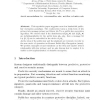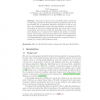BIOSIG
2009
14 years 5 months ago
2009
Abstract. This exposition paper suggests a new low-bandwidth publickey encryption paradigm. The construction turns a weak form of key privacy into message privacy as follows: let E...
ASIACRYPT
2010
Springer
14 years 5 months ago
2010
Springer
Blinding is a popular and well-known countermeasure to protect public-key cryptosystems against side-channel attacks. The high level idea is to randomize an exponentiation in order...
IEICET
2006
14 years 7 months ago
2006
We propose a new security class, called plaintext-simulatability, defined over the public-key encryption schemes. The notion of plaintext simulatability (denoted PS) is similar to ...
CRYPTO
2008
Springer
14 years 9 months ago
2008
Springer
We describe a public-key encryption system that remains secure even encrypting messages that depend on the secret keys in use. In particular, it remains secure under a "key cy...
PKC
2010
Springer
14 years 9 months ago
2010
Springer
ded abstract of this paper appears in 13th International Conference on Practice and Theory in Public Key Cryptography (PKC) 2010, Lecture Notes in Computer Science Vol. ?, P. Nguye...
CCS
2008
ACM
14 years 9 months ago
2008
ACM
Certificateless cryptography achieves the best of the two worlds: it inherits from identity-based techniques a solution to the certificate management problem in public-key encrypti...
122
click to vote
CRYPTO
1997
Springer
14 years 11 months ago
1997
Springer
We present a new proposal for a trapdoor one-way function, from which we derive public-key encryption and digital signatures. The security of the new construction is based on the ...
ASIACRYPT
2000
Springer
14 years 12 months ago
2000
Springer
This paper presents a secure and flexible Mix-net that has the following properties; it efficiently handles long plaintexts that exceed the modulus size of underlying public-key e...
EUROCRYPT
2010
Springer
15 years 10 days ago
2010
Springer
We construct the first public-key encryption scheme in the Bounded-Retrieval Model (BRM), providing security against various forms of adversarial “key leakage” attacks. In th...
EUROCRYPT
2003
Springer
15 years 23 days ago
2003
Springer
At CRYPTO 2000, a new public-key encryption based on braid groups was introduced. This paper demonstrates how to solve its underlying problem using the Burau representation. By thi...




